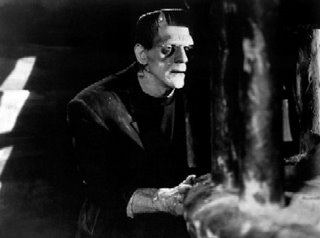A Termite Art Halloween: Frankenstein (1931)

I'd never seen Frankenstein before this week, but I had read it. Not the original Mary Shelley novel, mind you; I'd read the actual movie. As a youth in Marlboro, New Jersey's Frank Defino Central School, I was totally enthralled by the school library's series of heavily illustrated books about Hollywood's great movie monsters. Each book in the series (forgive me for not remembering the title — I wish I knew it so I could hunt them down on eBay) featured a different famous monster of filmland. The best part was that each book synopsized each character's numerous sequels, not just their debut feature. Before I'd seen a frame of Tod Browning's Dracula, I was well-versed in the intricate and often confusing continuties of Dracula's Daughter and Son of Dracula, and I would have been happy to tell you that House of Frankenstein preceded House of Dracula which preceded Abbott and Costello Meet Frankenstein when things really got out of hand.
Look, I was a weird kid.
Though all of these books, including volumes on The Wolf Man, The Creature From the Black Lagoon, The Mummy, and The Blob, made quite an impression on me in elementary school, I somehow avoided seeing any of them throughout my teenage and college years. While I caught up on myriad Friday the 13ths and Halloweens, I never actually saw the originals, the classics. Maybe because having read these books, laden with spoilers and juicy film stills, I felt like I'd already seen them, even though I hadn't.
And so it could happen that on Halloween 2006, at nearly 26 years old, I finally saw James Whale's 1931 Frankenstein fors the very first time. Even though I'd never seen the picture, and it has been decades since I'd even laid eyes on those old dusty library books, the film felt quite familiar: even before Young Frankenstein grave robbed all its tricks, this story of a mad scientist and his misunderstood creation had been remade or cannibalized a thousand times over, enough that I'd seen one or two of its imitators, if not the real thing.
There are two surprising aspects to Whale's Frankenstein. The first is that, made in 1931, the film is very much an early sound film. Undoubtedly the film helped establish an entire moviemaking genre, and Boris Karloff characterization of Frankenstein's monster has, with good reason, resonated with generations of moviegoers. But this is, in many ways, a rather crudely and often strangely made picture. Though it remains famous for Karloff's famous performance, I'd estimate that the movie has more jolly Bavarian dancing than scenes of monster rampage. And, frightening as a bunch of Oktoberfesting Germans can be, there's no question what I'd rather see more of.
I was also rather shocked to see that Frankenstein is, for all intents and purposes, not a horror film, despite the fact that I'd always been taught — partly by old library books — that it, along with Browning's Dracula, were the two pillars upon which an entire decade of Universal horror pictures were built. And of course, you have the requisite lab-coated madman, the crackling electrodes, the snarling assistant with the hump (named Fritz here, not Igor, that would come later) but really the only true terror is that inflicted on, rather than by, the poor monster.
Whale's most effective scene is built not out of horror, but sadness. The Monster escapes captivity and wanders the countryside. He stumbles on a little girl whose been left alone to play by the side of a pond. The innocent girl is the first human being to show the monster kindness after months of torture at the hands of Fritz and Frankenstein. She takes him by the hand and shows him how to play, tossing flower pedals into the lake. The Monster has so much fun he gets carried away, and when he runs out of flowers to throw, he tosses the little girl instead. Most of the film is shot on soundstages or backlot sets; Whale sets this scene in a seemingly real location of quiet, natural beauty. There is a genuine tenderness to the performance of the little girl (by a young Marilyn Harris, if IMDb is to be believed) and that makes her fate, and the ultimate fate of the monster's, that much more tragic.
Despite my background in movie monsters from all those books, I wasn't prepared for that. With their breathless pose and cool pictures of the monster busting loose, they didn't even hint at the true beauty the movie had in store.

2 Comments:
Frankenstein is definitely horror, and that's defined by Dr. Frankenstein and Co.'s angry, terror-filled reaction to the monster. The horror in this film is the image of the monster himself, he's an abomination, a freak of nature; the guy is put together with fragmented parts of other dead humans---dude, that's horror.
I'm so happy you finally watched it though, because it's one of my favorites, and if you liked that please see Bride of Frankenstein (1935)---it's even better. And you simply have to read Mary Shelley's original story, it's necessary.
I came upon Frankenstein while channel surfing last week, and saw the flower-pedal girl scene (before AMC cut away to commercial), and would agree that the scene is the heart of the film. Though I remember the grave robbing scene to be particularly haunting. B+W always seems to have the advantage of making gloom more uncomfortable.
Post a Comment
<< Home